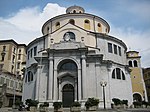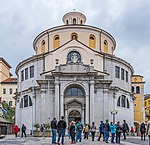Rijeka Synagogue
1780s establishments in Croatia1940s disestablishments in Croatia1944 disestablishments in Europe20th-century synagogues in EuropeAshkenazi Jewish culture in Croatia ... and 15 more
Ashkenazi synagoguesBuildings and structures demolished in 1944Buildings and structures destroyed during World War IIBuildings and structures in RijekaCroatian building and structure stubsCulture in RijekaDestroyed synagogues in CroatiaEuropean synagogue stubsInfobox religious building with unknown affiliationJewish organizations established in 1781Neolog Judaism synagoguesSynagogue buildings with domesSynagogues completed in 1903Synagogues destroyed by Nazi GermanyUse mdy dates from May 2024
The Rijeka Synagogue (Croatian: Riječka sinagoga), also called the Great Synagogue of Rijeka, was a former Neolog Jewish synagogue, located in Rijeka, Croatia. Completed in 1903, the synagogue served as the main synagogue of the city until it was destroyed by Nazis in 1944.
Excerpt from the Wikipedia article Rijeka Synagogue (License: CC BY-SA 3.0, Authors).Rijeka Synagogue
Korzo, Grad Rijeka Mjesni odbor Luka (Rijeka)
Geographical coordinates (GPS) Address Nearby Places Show on map
Geographical coordinates (GPS)
| Latitude | Longitude |
|---|---|
| N 45.32699 ° | E 14.44202 ° |
Address
Mali Cafe
Korzo 18
51000 Grad Rijeka, Mjesni odbor Luka (Rijeka)
Croatia
Open on Google Maps









